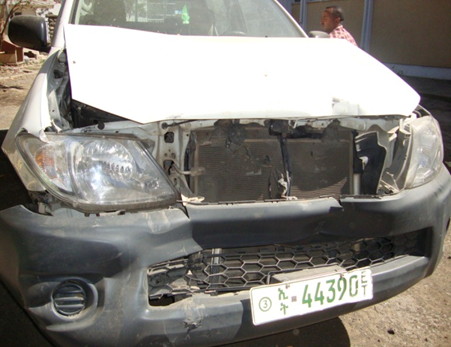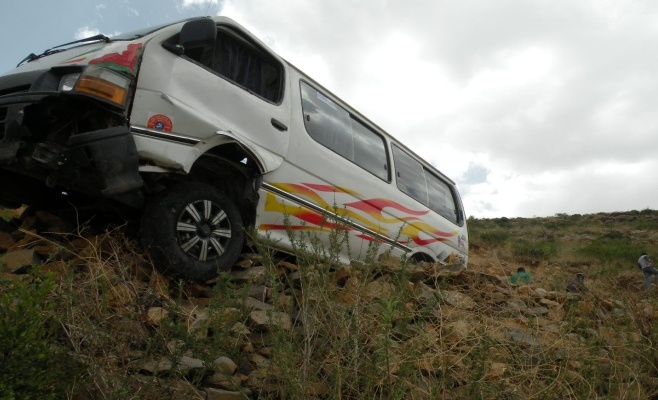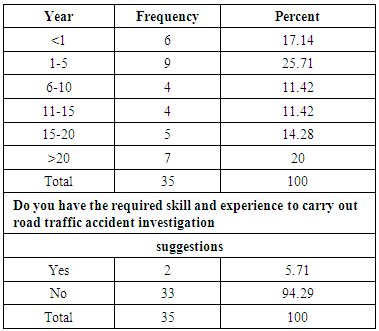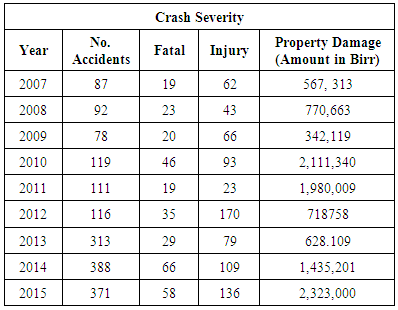-
Paper Information
- Previous Paper
- Paper Submission
-
Journal Information
- About This Journal
- Editorial Board
- Current Issue
- Archive
- Author Guidelines
- Contact Us
International Journal of Traffic and Transportation Engineering
p-ISSN: 2325-0062 e-ISSN: 2325-0070
2016; 5(4): 91-95
doi:10.5923/j.ijtte.20160504.02

Improvement of Traffic Accident Investigation Process: A Case Study in Mekelle City, Ethiopia
Assefa Bekele Meresa , Jin Xu , Shao Yiming
School of Traffic and Transportation, Chongqing Jiaotong University, Chongqing, China
Correspondence to: Assefa Bekele Meresa , School of Traffic and Transportation, Chongqing Jiaotong University, Chongqing, China.
| Email: |  |
Copyright © 2016 Scientific & Academic Publishing. All Rights Reserved.
This work is licensed under the Creative Commons Attribution International License (CC BY).
http://creativecommons.org/licenses/by/4.0/

Road Traffic accident investigation process requires precise data, pertaining to scene measurement which is necessary for analysing the collision dynamics that is used as evidence in court cases. This study presents findings on how different traffic accident investigations are carried out by traffic accident investigators in Mekelle city, one of the regional states of Ethiopia, with a high rate of accidents in relation to the number of cars on the road. It also presents the accident investigation approaches made by the investigators which includes, analysing the accident scene, planning the accident scene, measuring, and accident reporting. Due to the very informal nature of the investigation process, data has been collected by field observation in the actual traffic accident scenarios supported by interviews in the few cases and questionnaires and documentations in most cases. The findings of this paper showed that the accident investigation process carried out by the city’s traffic accident investigators are only based on tire skid marks and measuring tape. After careful analysis of the existing traffic accident investigation problems in the city, it has found, the city should apply the standard traffic accident investigation process to improving future road safeties, resource utilization, maintain smooth flow of work and avoid a hasty generalization in investigating vehicle accident scenarios.
Keywords: Traffic accident, Accident investigation, Mekelle city
Cite this paper: Assefa Bekele Meresa , Jin Xu , Shao Yiming , Improvement of Traffic Accident Investigation Process: A Case Study in Mekelle City, Ethiopia, International Journal of Traffic and Transportation Engineering, Vol. 5 No. 4, 2016, pp. 91-95. doi: 10.5923/j.ijtte.20160504.02.
Article Outline
1. Introduction
- Each day across the country, people and vehicles react unexpectedly, causing certain accidents which claims lives or cause permanent injuries. Hence, when an accident occurs, it is often not enough to simply say something went wrong. The real aim of road accident investigations is to reduce accident rates by making effective safety recommendations. If we do not solve the accident properly, our recommendations are likely to be ineffective. [1]Unless a close accident investigation and accident reconstruction is taken, the cause of a motor vehicle crash or other traffic accident may lead to some triggering factors. Thus, inadequate data gathering, incorrect manipulation of data and unsound logic in analysis will make things go wrong. [2]The world health organization report on road safety, reflecting information from 180 countries, indicates that worldwide the total number of road traffic deaths has plateaued at 1.25 million per year, with the highest road traffic fatality rates in low-income countries. [3]According to the World Health Organization’s (WHO) report, published in April 2014, traffic accidents in Ethiopia account for the deaths of 37.28 persons per 100,000. This is 2.77pc of the total deaths in the country, placing Ethiopia 12th in the world. [4]The most common investigation activities used for documenting road traffic accident scenes include: photography, collecting video data and scene measurements, followed by a detailed drawing of the scene [5]. Accurate, quality and comprehensive traffic accident reports are crucial for entering data into data banks and for performing spatial analyses. Recently, Khan et al. [6] re-viewed the traffic accident report forms that were used by the police departments in different districts and found that these forms can contain up to 99 different pieces of information pertaining to the accident scene. However, the accuracy and quality of these data did not reach a satisfactory level. Considering the technological progress made until to-day, modern measurement tools should be used and not ignored. Modern systems guarantee timely, fast, accurate, integrated, accessible, standardized and uniform data. Also, the measurement process should disrupt the traffic as little as possible and provide end products that are easily transformed into 2D drawings [7].The purpose of an accident investigation is not to assess blame, but to find the cause so it can be corrected. After determining the cause, the events leading up to the accident must be reconstructed. (J.V. Donald, 2000).According to Institute of Road Traffic Accident Investigators (ITAI) traffic accident investigations should be carried by a traffic police or independent investigator having at least the following skill and knowledge requirements. [8]Ÿ The ability to priorities information. Ÿ A methodical approach to gathering evidence. Ÿ The ability to pay very close attention to detail. Ÿ Excellent spoken and written communication skills. Ÿ Good mathematics and IT skills. Study ObjectiveIn Mekelle city, Ethiopia, improper traffic accident investigations and incomprehensive way of reporting have been carried out. This way of investigation has therefore been causing problems in justifying the exact causes of traffic road accidents and it has been hindering the improvement of future road accidents. Therefore, the study addressed the following key questions: how traffic polices are investigating vehicle accident scenarios? What accident investigation aids do they use? How to improve traffic investigations process and minimizing risks of investigation?
2. Methodology
- The strategy adopted in this research work was based on the following methodologies.
2.1. Data Collection
- Ÿ Obtaining published information from books, journals, and the internet to get relevant back-ground information on a standard traffic accident investigation process.Ÿ Observation of traffic accident investigation process as carried out at Mekelle city for eight weeks.Ÿ Interviews with Mekelle city Traffic Accident Investigators (MTAI), Traffic Unit of Mekelle city Police Service (TUMPS), drivers, and accident participants. Ÿ Questionnaires provided to traffic accident investigators.
2.2. Data Analysis
- The collected data was analysed quantitatively in the form of tabulation and qualitatively with intuitive judgment.
3. Result
- The study was conducted in Mekelle city, which is located in Northern Ethiopia with a total population of 480,217. The city has a high rate of accidents in relation to the number of vehicles on the road. Data was collected by referring previously made investigation reports, preparing questionnaire, interviews and direct physical observation (main study). The collected data was analysed quantitatively in the form of tabulation and qualitatively with intuitive judgment.
3.1. Socio Demographic and Background Characteristics
- Majority of the respondents 28(80%) were males. The mean age of the study subject was 36.8. The majority of the respondents’ educational statuses were high school completed 15 (42.85%) followed by college diploma.
|
3.2. Skill and Experience
- The work experience of the investigators was between the ranges of 1 year to 20 years. The majority work experience of the respondents was in the age of 15-20 years (14.28%). A question was raised to study whether they have the required skill and experience to carry out road traffic accident scenarios, and the majority of the respondents answer was “No”.
|
3.3. Training Adequacy
- 33(94.29%) of the respondents answered, they didn’t have the required skill and investigation aids to undergo road traffic accident investigations.
3.4. Background of the Investigators
- The various road traffic accident investigations done in Mekelle city were often carried out by traffic polices with little background in vehicle accident investigation science in general and knowledge of automobiles in particular.
3.5. Rate of Road Traffic Accident
- From the year 2007-2015 over 1,675 road traffic accidents occurred. Out of which, over 315 people were died, over 780 people were suffered with easy and series non-fatal accidents and a property lose which accounts over 10,876,512 Birr had occurred. Graph 1. reveals the road traffic accidents occurred from 2007-2015.
 | Graph 1. Rate of traffic accidents in Mekelle city, Ethiopia |
3.6. Crash Severity
- The number of crashes occurred in the specified years in shown in table 3.
|
3.7. Existing Traffic Accident Investigation Process
- All investigation processes in Mekelle City were carried out according to what they have learnt from their predecessors. There were no detailed documentations on how jobs are accomplished or records of jobs that have been carried out for reference purposes. Due to this reason, it was very difficult to obtain related statistical data.
3.8. Main Investigation Process
3.8.1. Arrival at the Scene
- Up on arrival at the accident scene, their first step was to take care of injured or dead victims and sent them to a nearby hospital for medical treatments. Then their next step was to protect the scene by rerouting other incoming traffics. Then they recorded information like date of accident, place of inspection, vehicle color, type of accident, vehicle license number, direction of travel, number of people injured, dead, cause of accident and estimated property damage in birr.However, the investigators didn’t consider the other basic points (cars registration number, cars year of manufacture, pre-accident condition, pre-accident market value and assessed salvage value, dimensions of vehicle, odometer reading) that have to be included in a standard accident investigation form.
3.8.2. Describing Point of Impact
- The investigators in Mekelle city did not use standard figures to express and determine the point and direction of impact in order to relate the vehicle damage to the circumstances of the accident.
3.8.3. Moving Vehicle and Marking Wheels
- Investigators moved vehicles to takeout the injured person trapped in the wreckage and made a way to an oncoming vehicle.
3.8.4. Identify and Preserve Fragile Evidence
- The investigators didn’t perform the process of identifying and preserving fragile evidences that can be damaged, altered, destroyed or removed from the scene by any willful or negligent act.
3.8.5. Take Statements
- Questioning and taking statements of witnesses and victims at the scene in some cases, were part of the activities carried out by the investigators. However, their approach in doing so was not systematic enough.
3.8.6. Tyre Marks
- The investigators did not use tire marks to determine the speed at which the vehicle was traveling. They instead conclude the cause without any physics or mathematical resolutions.
3.8.7. Sketches
- Depending on the type and severity of an accident, sketches are carried out by the investigators. However their sketches were not on scaled drawings or a systematic procedures and references.
3.8.8. Measurements
- Accurate measurements are necessary to relocate and re-late exact points in an accident scene. However, the investigators didn’t perform accurate measurements; they instead, did a simple measurement to indicate how long the participant was out of the main lane.
3.8.9. Photography
- Although they knew photographs are important to supplement an accident investigation, investigators didn’t take photographs as a means of describing the accident scene. The reason for this was they were not equipped with such kind of investigation aids. Figures 1(a) and 1(b) shows some of the photographs taken by the study during the actual scenarios.
 | Figure 1(a). Frontal car crush taken during the study time |
 | Figure 1(b). Side collision of a minibus taken during the study time |
 | Figure 1(c). A roll-over vehicle in one of the city’s mountains |
3.8.10. Investigating Vehicular Defects
- After sketching, measuring the accident scene, the main investigator called technical investigator to carry out inspection of the vehicle(s) condition and damage. Although the purpose was to obtain supporting information concerning statements of witnesses and their own conclusions, when made, the investigators didn’t perform vehicular defect inspections properly using proper investigation aids.
3.8.11. Completing Investigation
- The investigator gave a due attention to distinguish the traffic law violators and set charges or sent them to a court. Their written form of statement was filled in the sketch paper and didn’t include additional diagrams, statements and photographs in addition to the accident report. The statements made didn’t clearly distinguish between fact and opinion.
3.8.12. Data from Different Documents
- Documents referred during the work were: Annual accident investigation reports from 2007-2015., daily investigation report forms, type of trainings given.
3.8.13. Data from Direct Physical Observation-Main Study Activities
- The investigation process: A total of 31 traffic accident scenarios were visited during the survey and it was observed that the investigation processes adopted in accomplishing these traffic accident scenarios were mainly based on tyre skid marks and measuring tape.
4. Problems and Proposed Solutions
4.1. Main Problems
- The main target of the study was to improve traffic accident investigation process so as to bring an improvement in future road safeties by proposing solutions for the existing problems. As it was taken from the collected data the following were identified as major problems that influences the determination of the exact causes of accidents which in turn influences the improvement in future road safeties: Ÿ Lack of awarenessŸ Low level of educationŸ Lack of skill and knowledgeŸ Training inadequacies and lack of investigation aids and investigation facilities.
4.2. Proposed Solutions
- The study proposes the following solutions for the identified problems:
4.2.1. Lack of Awareness
- Creating awareness about traffic accident investigation in general and determining the exact causes of the accident in particular minimizes the faults in investigations.
4.2.2. Low Level of Education
- The investigators should upgrade their education to adapt technological changes in road traffic investigation areas. Thus, the government and concerned bodies should give emphasis in up grading the investigators educational level.
4.2.3. Lack of Skill and Knowledge
- Despite the fact that short trainings were given to the investigators, their skill and knowledge in the investigation science remains very poor. The government or concerned bodies have therefore upgrade the skill and knowledge of the investigators with more emphasis to subjects like physics (collision and momentum), mathematics, information technologies and knowledge of automobiles.
4.2.4. Training Inadequacies
- The trainings given to the investigators were infrequent and inadequate. Thus, successive and relevant trainings have to be given by concerned bodies to solve the problems faced by the investigators.
4.2.5. Lack of Investigation Aids and Investigation Facilities
- The investigators were using only measuring meter as an accident investigation aid. They were highly suffering with these problems and have reported to concerned bodies. But they were still forced to work with aged and inappropriate measuring device. Concerned bodies have therefore; fulfil the necessary investigation aids that can help facilitate their investigation processes with more accurate determination of the exact causes for a particular accident.
5. Conclusions
- After careful analysis of the existing Mekelle city’s road traffic accident investigation problems, the following conclusions were made.Ÿ The educational status of the investigators should be improved so as to familiarize with standard traffic accident investigations.Ÿ Training should be given for the employees with certain time period to update their knowledge and skill to the latest road traffic investigation technologies.Ÿ The traffic unit should implement standard traffic accident investigation to reduce doubts and improve future road safeties.Ÿ Since the causes of the accidents were not well defined, the rate of accidents in the city was largely increasing.Ÿ The number of the investigators should be increased to cover the cities accident sites. Ÿ Road traffic accident investigation aides and facilities such as ambulance, first aids, cameras, computer and well organized offices have to be fulfilled.
 Abstract
Abstract Reference
Reference Full-Text PDF
Full-Text PDF Full-text HTML
Full-text HTML

